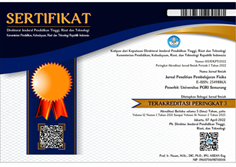Implementation Artificial Intelligence with Natural Language Processing Method to Improve Performance of Digital Product Sales Service
DOI:
https://doi.org/10.26877/asset.v6i3.521Keywords:
Artificial Intelligence, Natural Language Processing, Sales Service, Digital ProductAbstract
Improving the performance of digital product sales services is the main focus of the company's attention in the face of increasingly fierce competition in the online market. In order to optimize these services, Artificial Intelligence (AI) technology with the Natural Language Processing (NLP) method is an attractive option. This research aims to find out how the application of AI with Natural Language Processing (NLP) can contribute to improving the performance of digital product sales services. The methods used in this research include collecting data on customer interactions via WhatsApp that have implemented artificial intelligence with the Natural Language Processing (NLP) method. The data is then analyzed using Natural Language Processing (NLP) techniques to understand the needs, preferences, and problems faced by customers. Natural Language Processing (NLP) assists the chatbot in correcting incoming questions if they do not match the database on the question. Differences that can be helped by Natural Language Processing (NLP) if there is inappropriate capitalization, excessive conjunctions. The results show that the application of AI with Natural Language Processing (NLP), can enable companies to be more responsive to customer needs and improve overall customer satisfaction. With in-depth analysis of customers' natural language data, companies can provide more relevant services and empower sales teams to provide faster and more accurate responses. This can be seen from the quality of service results which have a point of 4.1, this value indicates a good response from customers so that the system is considered to have improved sales services by buyers.
References
P. A. Alia, J. S. Prayogo, R. Kriswibowo, and A. T. Setyadi, “Implementation Open Artificial Intelligence ChattGPT Integrated With Whatsapp Bot,” Advance Sustainable Science, Engineering and Technology, vol. 6, no. 1, p. 02401019, Jan. 2024, doi: 10.26877/ASSET.V6I1.17909.
J. Becker et al., “Artificial Intelligence-Based Detection of Pneumonia in Chest Radiographs,” Diagnostics, vol. 12, no. 6, 2022, doi: 10.3390/diagnostics12061465.
W. H. Curioso and M. J. Brunette, “Artificial intelligence and innovation to optimize the tuberculosis diagnostic process,” Rev Peru Med Exp Salud Publica, vol. 37, no. 3, 2020, doi: 10.17843/rpmesp.2020.373.5585.
M. D. Kurniawan and H. Haryanto, “GOMS-based User Experience for Cultural Tourism Application in Indonesia,” Advance Sustainable Science, Engineering and Technology, vol. 6, no. 1, p. 02401016, Jan. 2024, doi: 10.26877/ASSET.V6I1.17862.
M. Rafid, A. Luthfiarta, M. Naufal, M. Daffa, A. Fahreza, and M. Indrawan, “The Effect of LAB Color Space with NASNetMobile Fine-tuning on Model Performance for Crowd Detection,” Advance Sustainable Science, Engineering and Technology, vol. 6, no. 1, p. 02401014, Jan. 2024, doi: 10.26877/ASSET.V6I1.17821.
M. R. Firmansyah and Y. P. Astuti, “Stroke Classification Comparison with KNN through Standardization and Normalization Techniques,” Advance Sustainable Science, Engineering and Technology, vol. 6, no. 1, p. 02401012, Jan. 2024, doi: 10.26877/ASSET.V6I1.17685.
M. Y. Hadiyanto, B. Harsono, and I. Karnadi, “Zonation Method for Efficient Training of Collaborative Multi-Agent Reinforcement Learning in Double Snake Game,” Advance Sustainable Science, Engineering and Technology, vol. 6, no. 1, p. 02401011, Dec. 2024, doi: 10.26877/ASSET.V6I1.17562.
R. A. Ramadhan, D. Swanjaya, and R. Helilintar, “Optimizing Predictive Accuracy: A Study of K-Medoids and Backpropagation for MPX2 Oil Sales Forecasting,” Advance Sustainable Science, Engineering and Technology, vol. 6, no. 1, p. 02401010, Dec. 2024, doi: 10.26877/ASSET.V6I1.17665.
G. Widotomo, D. Nurkertamanda, and H. Suliantoro, “Improving Analysis of Risk-Based Maintenance Management Strategies Through Reliability Centered Maintenance. Case Study : Coal Crushing Plant. Central Kalimantan. Indonesia,” Advance Sustainable Science, Engineering and Technology, vol. 6, no. 1, p. 0240109, Dec. 2024, doi: 10.26877/ASSET.V6I1.17529.
A. N. Cahyani, J. Zeniarja, S. Winarno, R. Tsaniya, E. Putri, and A. A. Maulani, “Heart Disease Classification Using Deep Neural Network with SMOTE Technique for Balancing Data,” Advance Sustainable Science, Engineering and Technology, vol. 6, no. 1, p. 0240108, Dec. 2024, doi: 10.26877/ASSET.V6I1.17521.
A. P. Cahyani and A. Susanto, “A Good Result for Blowfish Image Encryption Based on Stepic,” Advance Sustainable Science, Engineering and Technology, vol. 6, no. 1, p. 0240107, Dec. 2024, doi: 10.26877/ASSET.V6I1.17332.
P. W. Permatasari and J. Aryanto, “Overcoming The Buildup of Queues By Carrying Out the Concept of Self-Service Using Responsive Web-Based Applications,” Advance Sustainable Science, Engineering and Technology, vol. 6, no. 1, p. 0240105, Dec. 2024, doi: 10.26877/ASSET.V6I1.17440.
A. S. Dewantara and J. Aryanto, “Implementation Of A Web-Based Chatbot Using Machine Learning For Question And Answer Services In Universities,” Advance Sustainable Science, Engineering and Technology, vol. 6, no. 1, p. 0240106, Dec. 2024, doi: 10.26877/ASSET.V6I1.17590.
A. P. Cahyani and A. Susanto, “A Good Result for Blowfish Image Encryption Based on Stepic,” Advance Sustainable Science, Engineering and Technology, vol. 6, no. 1, p. 0240107, Dec. 2024, doi: 10.26877/ASSET.V6I1.17332.
E. Hertnacahyani Herraprastanti, M. A. Ashraf, Y. Martin, S. Saputra, and H. Suryanto, “Portable Incinerator Capacity of 5000 Grams with Used Fuel Oil,” Advance Sustainable Science, Engineering and Technology, vol. 6, no. 1, p. 0240103, Dec. 2024, doi: 10.26877/ASSET.V6I1.17108.
I. P. Kamila, C. A. Sari, E. H. Rachmawanto, and N. R. D. Cahyo, “A Good Evaluation Based on Confusion Matrix for Lung Diseases Classification using Convolutional Neural Networks,” Advance Sustainable Science, Engineering and Technology, vol. 6, no. 1, p. 0240102, Dec. 2024, doi: 10.26877/ASSET.V6I1.17330.
E. A. Sofyan, C. A. Sari, E. H. Rachmawanto, and N. R. D. Cahyo, “High-Quality Evaluation for Invisible Watermarking Based on Discrete Cosine Transform (DCT) and Singular Value Decomposition (SVD),” Advance Sustainable Science, Engineering and Technology, vol. 6, no. 1, p. 0240101, Dec. 2024, doi: 10.26877/ASSET.V6I1.17186.
R. Maylano, Y. #1, W. Widiarto, and A. Wijayanto, “Otomasi dan Monitoring Hidroponik pada Tanaman Selada dengan Metode Sonic Bloom Berbasis IoT,” JEPIN (Jurnal Edukasi dan Penelitian Informatika), vol. 8, no. 3, pp. 422–431, Dec. 2022, doi: 10.26418/JP.V8I3.57392.
A. Yuniar and R. #1, “Klasifikasi Citra Burung Jalak Menggunakan Artificial Neural Network dan Random Forest,” JEPIN (Jurnal Edukasi dan Penelitian Informatika), vol. 8, no. 2, pp. 255–268, Aug. 2022, doi: 10.26418/JP.V8I2.53480.
A. Suparno and S. Yos Sudarso Purwokerto, “Chat Bot sebagai implementasi Pemanfaatan Teknologi Artificial Intelligence dengan Channel Telegram,” vol. 12, p. 2020, doi: 10.33488/1.ma.2.1.275.











